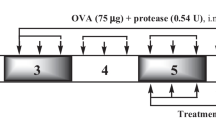Abstract
The objective of this study is to establish a mouse model of acute bacterial rhinosinusitis. 179 healthy male BALB/c mice were divided into four groups in this randomized and controlled study. Sponge slivers impregnated with methicillin-resistant Staphylococcus aureus (MRSA COL) suspension were inserted into the right nasal cavities for group A; sponge slivers impregnated with sterile saline were inserted into the right nasal cavities for group B; group C mice were inoculated with MRSA COL suspension in right nasal cavities; group D was control group without any treatment. Mice were killed on days 1, 4, 7 and 14, respectively. Nasal lavage fluid was prepared for microbiological culture. Histological examinations of nasal specimens were performed to observe the severity of inflammatory reaction. Acute bacterial rhinosinusitis was induced in all group A mice. Less severe inflammation was seen in partial group B mice compared with that in group A mice (P ≤ 0.05). No inflammatory reaction was found in group C and D mice. In conclusion, a mouse model of acute bacterial rhinosinusitis has been developed successfully using an easier, less invasive and potentially more reversible technique than those used in previous studies.



Similar content being viewed by others
References
Bomer K, Brichta A, Baroody F (1998) A mouse model of acute bacterial rhinosinusitis. Arch Otolaryngol Head Neck Surg 124:1227–1232
Kiser KB, Cantey-Kiser JM, Lee JC (1999) Development and characterization of a Staphylococcus aureus nasal colonization model in mice. Infect Immun 67:5001–5006
Kruszewskal D, Sahl H-G, Bierbaum G (2004) Mersacidin eradicates methicillin-resistant Staphylococcus aureus (MRSA) in a mouse rhinitis model. J Antimicrob Chemother 54:648–653
Schaffer AC, Solinga RM, Cocchiaro J (2006) Immunization with Staphylococcus aureus clumping factor B, a major determinant in nasal carriage, reduces nasal colonization in a murine model. Infect Immun 74:2145–2153
Kara CO, Cetin CB, Demirkan N (2004) Experimental sinusitis in a rhinogenic model. Laryngoscope 14:273–278
Kluytmans J, van Belkum A, Verbrugh H (1997) Nasal carriage of Staphylococcus aureus: epidemiology, underlying mechanisms, and associated risks. Clin Microbiol Rev 10:505–520
Chang S, Sievert DM, Hageman JC, Boulton ML, Tenover FC, Pouch Downes F, Shah S, Rudrik JT, Pupp GR, Brown WJ, Cardo D, Fridkin SK (2003) Infection with vancomycin-resistant Staphylococcus aureus containing the vanA resistance gene. N Engl J Med 348:1342–1347
Von Eiff C, Becker K, Machka K et al (2001) Nasal carriage as a source of Staphylococcus aureus bacteremia Study Group. N Engl J Med 344:11–16
Peacock SJ, de Silva I, Lowy FD (2001) What determines nasal carriage of Staphylococcus aureus? Trends Microbiol 9:605–610
Cole AM, Tahk S, Oren A et al (2001) Determinants of Staphylococcus aureus nasal carriage. Clin Diagn Lab Immunol 8:1064–1069
Kokai-Kun JF, Walsh SM, Chanturiya T, Mond JJ (2003) Lysostaphin cream eradicates Staphylococcus aureus nasal colonization in a cotton rat model. Antimicrob Agents Chemother 47:1589–1597
Wang H, Xiang L, Cao P-P (2008) Histological and immunological observations of bacterial and allergic chronic rhinosinusitis in the mouse. Am J Rhinol 22:343–348
González-Zorn B, Senna JPM, Fiette L (2005) Bacterial and host factors implicated in nasal carriage of methicillin-resistant Staphylococcus aureus in mice. Infect Immun 73:1847–1851
Jacob A, Faddis BT, Chole RA (2001) Chronic bacterial rhinosinusitis, description of a mouse model. Arch Otolaryngol Head Neck Surg 127:657–664
Liang K-L, Jiang R-S, Wang J (2008) Developing a rabbit model of rhinogenic chronic rhinosinusitis. Laryngoscope 118:1076–1081
Acknowledgments
This study was supported by the National Nature Science Foundation of China (NSFC) 30872849.
Author information
Authors and Affiliations
Corresponding author
Rights and permissions
About this article
Cite this article
Jin, M., Gu, Z., Bian, Z. et al. Developing a mouse model of acute bacterial rhinosinusitis. Eur Arch Otorhinolaryngol 268, 857–861 (2011). https://doi.org/10.1007/s00405-011-1483-4
Received:
Accepted:
Published:
Issue Date:
DOI: https://doi.org/10.1007/s00405-011-1483-4




